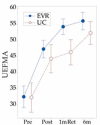Virtual Rehabilitation of the Paretic Hand and Arm in Persons With Stroke: Translation From Laboratory to Rehabilitation Centers and the Patient's Home
- PMID: 33584529
- PMCID: PMC7876436
- DOI: 10.3389/fneur.2021.623261
Virtual Rehabilitation of the Paretic Hand and Arm in Persons With Stroke: Translation From Laboratory to Rehabilitation Centers and the Patient's Home
Abstract
The anatomical and physiological heterogeneity of strokes and persons with stroke, along with the complexity of normal upper extremity movement make the possibility that any single treatment approach will become the definitive solution for all persons with upper extremity hemiparesis due to stroke unlikely. This situation and the non-inferiority level outcomes identified by many studies of virtual rehabilitation are considered by some to indicate that it is time to consider other treatment modalities. Our group, among others, has endeavored to build on the initial positive outcomes in studies of virtual rehabilitation by identifying patient populations, treatment settings and training schedules that will best leverage virtual rehabilitation's strengths. We feel that data generated by our lab and others suggest that (1) persons with stroke may adapt to virtual rehabilitation of hand function differently based on their level of impairment and stage of recovery and (2) that less expensive, more accessible home based equipment seems to be an effective alternative to clinic based treatment that justifies continued optimism and study.
Keywords: arm; hand; rehabilitation; stroke; virtual reality.
Copyright © 2021 Fluet, Qiu, Patel, Mont, Cronce, Yarossi, Merians and Adamovich.
Conflict of interest statement
GF, QQ, AMo, AC, AMe, and SA have applied for a patent for the Home Virtual Rehabilitation System. QQ, AMo, and AC have interests in NeuroTech3R, a company working toward bringing the Home Virtual Rehabilitation System to market. The remaining authors declare that the research was conducted in the absence of any commercial or financial relationships that could be construed as a potential conflict of interest.
Figures


Similar articles
-
Exploring the impact of visual and movement based priming on a motor intervention in the acute phase post-stroke in persons with severe hemiparesis of the upper extremity.Disabil Rehabil. 2017 Jul;39(15):1515-1523. doi: 10.1080/09638288.2016.1226419. Epub 2016 Sep 16. Disabil Rehabil. 2017. PMID: 27636200 Free PMC article.
-
Motor skill changes and neurophysiologic adaptation to recovery-oriented virtual rehabilitation of hand function in a person with subacute stroke: a case study.Disabil Rehabil. 2017 Jul;39(15):1524-1531. doi: 10.1080/09638288.2016.1226421. Epub 2016 Sep 27. Disabil Rehabil. 2017. PMID: 27669997 Free PMC article.
-
Robotically facilitated virtual rehabilitation of arm transport integrated with finger movement in persons with hemiparesis.J Neuroeng Rehabil. 2011 May 16;8:27. doi: 10.1186/1743-0003-8-27. J Neuroeng Rehabil. 2011. PMID: 21575185 Free PMC article.
-
Rehabilitation of arm function after stroke. Literature review.Ann Phys Rehabil Med. 2009 Apr;52(3):269-93. doi: 10.1016/j.rehab.2008.10.003. Epub 2009 Apr 9. Ann Phys Rehabil Med. 2009. PMID: 19398398 Review. English, French.
-
Efficacy assessment of virtual reality therapy for neuromotor rehabilitation in home environment: a systematic review.Disabil Rehabil Assist Technol. 2023 Oct;18(7):1200-1220. doi: 10.1080/17483107.2021.1998674. Epub 2021 Nov 11. Disabil Rehabil Assist Technol. 2023. PMID: 34761705
Cited by
-
Influence of the Passive Stabilization of the Trunk and Upper Limb on Selected Parameters of the Hand Motor Coordination, Grip Strength and Muscle Tension, in Post-Stroke Patients.J Clin Med. 2021 May 29;10(11):2402. doi: 10.3390/jcm10112402. J Clin Med. 2021. PMID: 34072303 Free PMC article.
-
Laboratory-Based Examination of the Reliability and Validity of Kinematic Measures of Wrist and Finger Function Collected by a Telerehabilitation System in Persons with Chronic Stroke.Sensors (Basel). 2023 Feb 28;23(5):2656. doi: 10.3390/s23052656. Sensors (Basel). 2023. PMID: 36904860 Free PMC article.
-
Myoelectric control and virtual reality to enhance motor rehabilitation after stroke.Front Bioeng Biotechnol. 2024 Apr 11;12:1376000. doi: 10.3389/fbioe.2024.1376000. eCollection 2024. Front Bioeng Biotechnol. 2024. PMID: 38665814 Free PMC article.
References
-
- iBadia BS, Fluet GG, Llorens R, Deutsch JE. Virtual reality for sensorimotor rehabilitation post stroke: design principles and evidence. In: Reinkensmeyer D, Dietz V. editors. Neurorehabilitation Technology. Cham: Springer; (2016). p. 573–603. 10.1007/978-3-319-28603-7_28 - DOI
Grants and funding
LinkOut - more resources
Full Text Sources
Other Literature Sources
Miscellaneous

